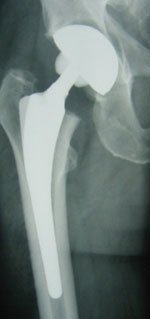Cementless straight stem proved bone preserving and less invasive
Belgian and French orthopedists determined a new bone-preserving straight, cementless hip stem proved less invasive, preserved bone and performed as well as other hip stems, according to a recently presented study.
Didier Mainard, MD, presented findings from the prospective study at the SICOT XXV Triennial World Congress 2011 in Prague.
“Uncemented stems can have the same good results as the cemented stem,” Mainard told Orthopedics Today in an interview.
Merits of the new stem
|
Image: Mainard D |
Mainard and colleagues theorized a stem coated with a special calcium phosphate called brushite would better preserve bone biology and invented a new uncemented stem that used the material, the Excia implant (B. Braun; Tuttlingen, Germany). The femoral prosthesis is coated proximally with titanium plasma and brushite.
“Brushite is a special calcium phosphate which is particularly bioabsorbable,” Mainard said. “It gives calcium and phosphate ions release which increases bioactivity and bone preservation. It has very quick dissolution and resorption in less than 3 months. It is better that bone is in contact with brushite from a biological point of view and with titanium plasma than with cement, because there is a direct link between bone and calcium phosphate and over time the contact between cement and bone is always an issue and can make some debris.”
Other merits of the new stem included its anterior and posterior flanges which increase surface contact with bone, preserve bone stock and reduce subsidence, according to the abstract, in which investigators noted rasping until cortical bone is reached is not necessary to achieve stability with this hip device and its lateral wings halt rotation.
Study design
Mainard and colleagues prospectively studied 237 consecutive primary total hip arthroplasties performed with the stem. The patients had an average age of 61 years and were followed for an average 6.5 years. Investigators measured outcomes using the Harris Hip score (HHS), Kaplan-Meier stem survivorship, the Agora Roentgenographic Assessment (ARA) and the Engh-Massin score.
The investigators reported few complications aside from needing to explant three stems; two for periprosthetic fractures and one for pain.
“This kind of stem may give slight thigh pain and of course we have thigh pain,” Mainard said. “This pain decreased over time and in our series, at the third year, we no longer had thigh pain.” At 1 year, 3.9% of patients experienced thigh pain. At 2 years, 2.3% had thigh pain. However, by 3 years follow-up, no patients reported thigh pain.
The preoperative HHS increased from 46 points to 97 points postoperatively and the Kaplan-Meier stem survival rate was 98.72%. Postoperatively, the mean ARA score was 5.7 and the Engh-Massin score was 25.25. The stem achieved osseointegration in all but one patient, which Mainard said was “a very special case” because the patient had a kidney graft.
“What I expect at 10 years follow-up is, of course, the same good results,” Mainard said. – by Renee Blisard
Reference:
- Mainard D, Mayer J, Guignand D, et al. Results of a bone preserving cementless straight hip stem – A prospective study with a minimum follow-up of 5 years. Paper #29247. Presented at the SICOT XXV Triennial World Congress 2011. Sept. 6-9. Prague.

- Didier Mainard, MD, can be reached at Henri Poincaré University, 24-30 Rue Lionnois - BP 60121, 54 003 Nancy Cedex, France; 33 3838 51782; email: didier.mainard@medecine.uhp-nancy.fr.
- Disclosure: Mainard receives royalties from B. Braun.
As with many modern stem designs, the authors have demonstrated excellent mid-term survival and a low rate of revision with this cementless straight stem. The authors should be congratulated on achieving a prospective and consecutive series.
Assuming that this represents a consecutive series of total hip arthroplasties and not a consecutive series of cases in which the surgeon chose to use this stem design, it would appear that the results are excellent in patients of all ages, bone types, and disease. I am, uncertain, how this stem, with its nearly 99% survival, differs in terms of bone preservation. It will be interesting to follow this series and document bone preservation and a lack of stress shielding over the longer term. Many stem designs, whether they be tapered, straight or metaphyseal filling, have achieved primary stability and excellent mid-term results; and this design can be added to that list.
Lastly, I do have concern over the presence of thigh pain. The authors report one stem revised for this condition, and I wonder what the incidence of significant thigh pain is with this straight design.
— Keith R. Berend, MD
Joint Implant
Surgeons, Inc.
New Albany, Ohio
Disclosure: Berend earns
royalties from, is a consultant for and is on the speaker’s bureau for
Biomet.











